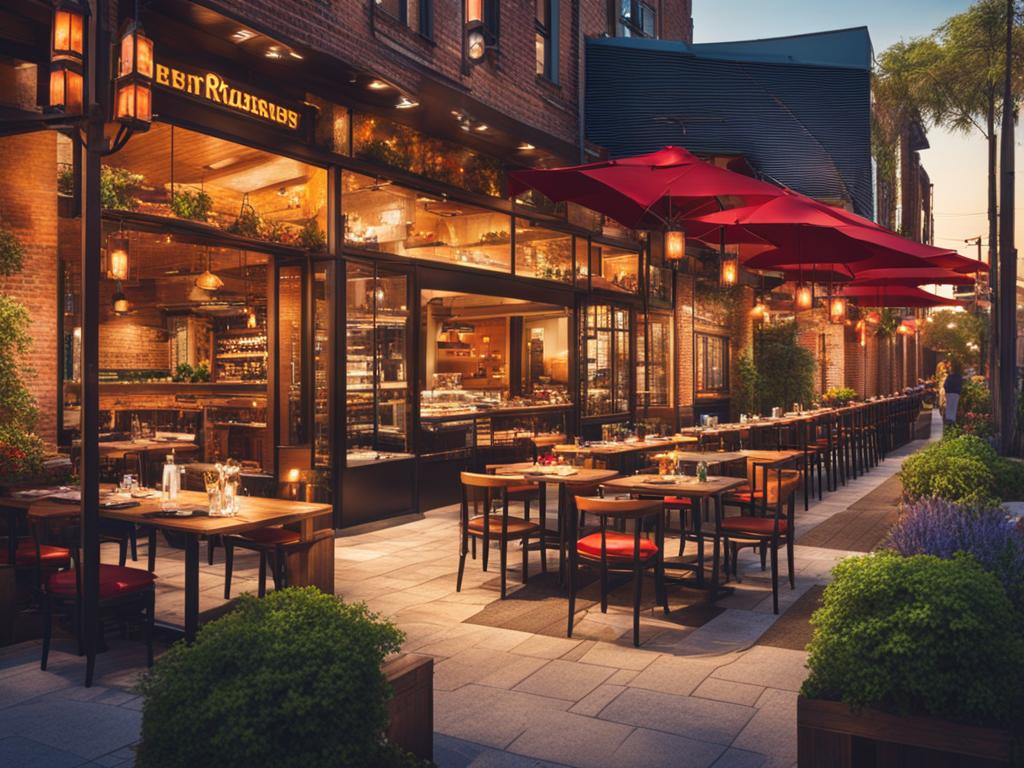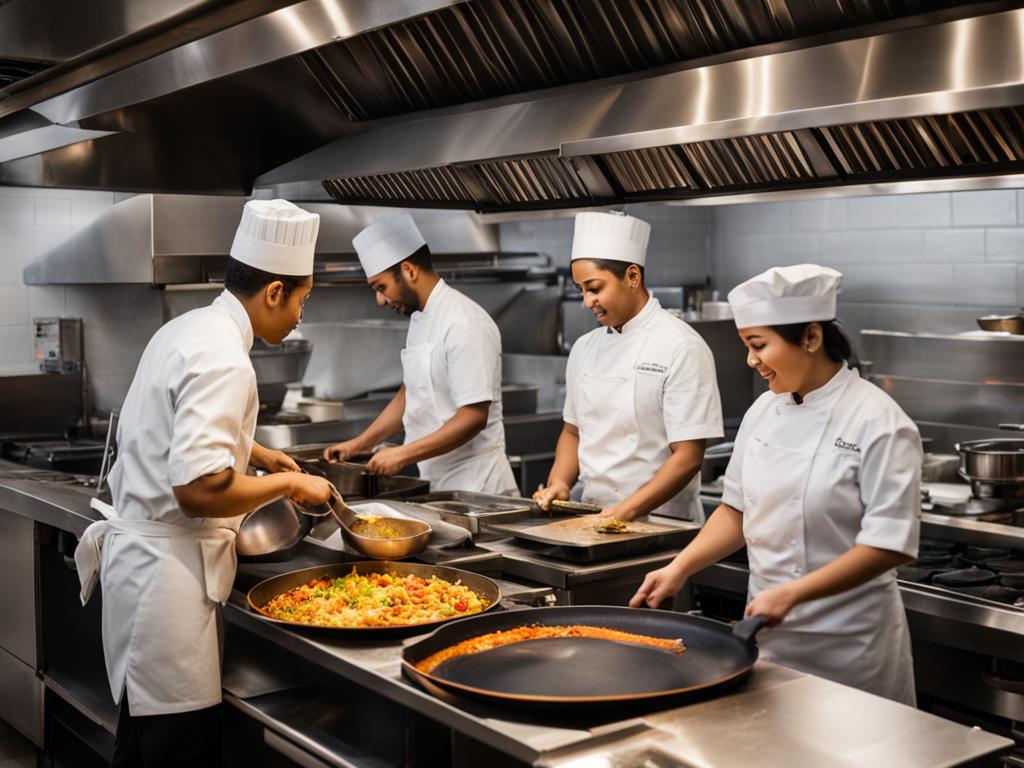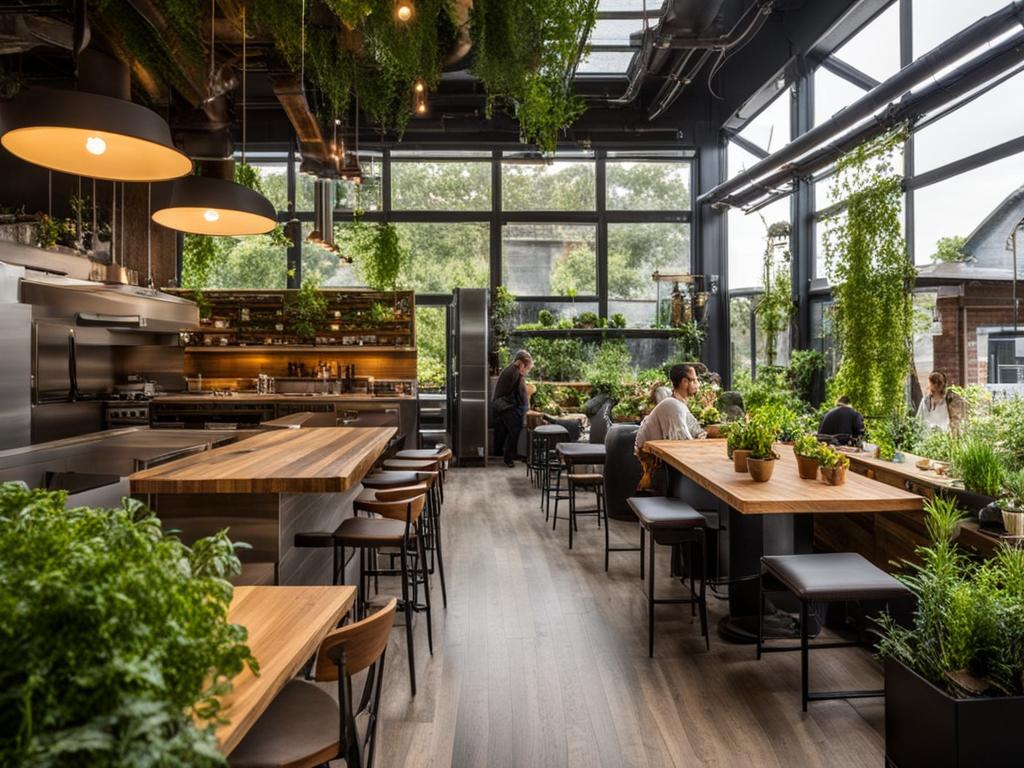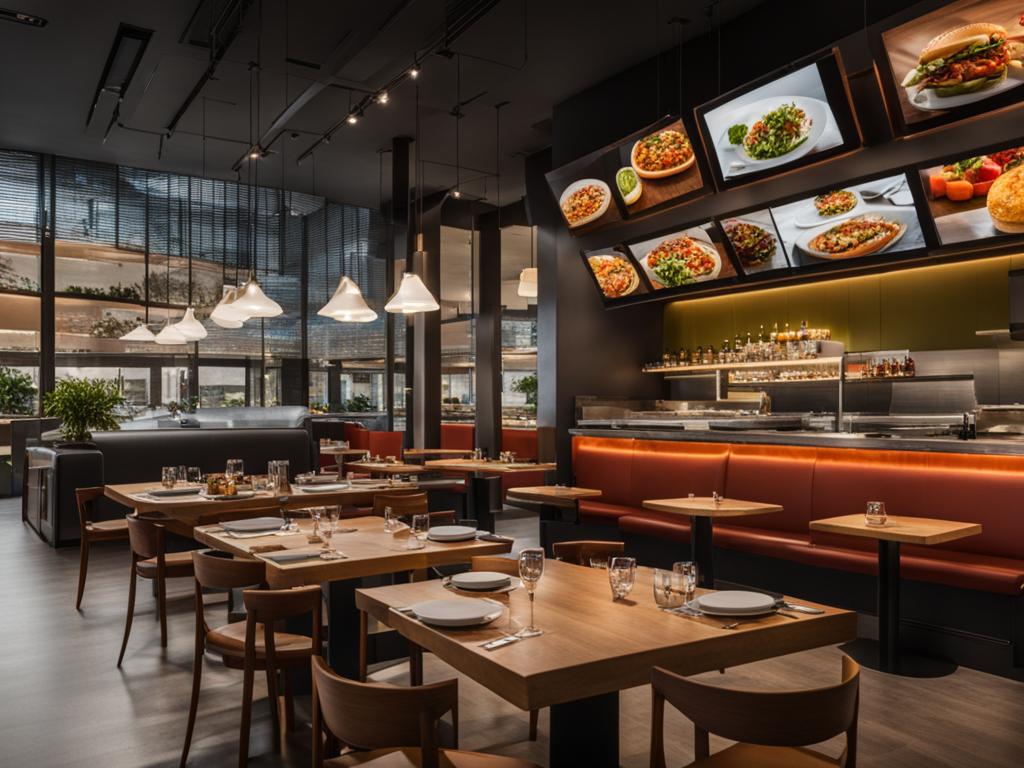Unlock Success: How to Start a Restaurant with No Money
Starting a restaurant with no money may seem challenging, but with the right strategies and mindset, it is possible to turn your passion into profit. In this article, we will explore practical steps and proven strategies to help you kick-start your dream restaurant even on a tight budget.
Key Takeaways
- Starting a restaurant without capital is possible with the right approach and determination.
- Conduct thorough market research to understand your target audience and competition.
- Create an enticing menu that caters to diverse preferences.
- Choose a strategic location that aligns with your target audience and complements your restaurant concept.
- Navigate through the necessary licenses and permits to ensure compliance.
Conduct Market Research: Understanding Your Audience and Competition
Before starting a restaurant with no money, conducting thorough market research is essential. This research provides valuable insights into your target audience’s preferences, demographics, and spending habits, helping you tailor your restaurant concept effectively. Additionally, analyzing your competitors can offer insights into what works and what doesn’t in the market, allowing you to differentiate yourself and stay ahead.
Target Audience Analysis: Identifying your target audience is the first step in conducting effective market research. Consider factors such as age, income level, interests, and location. Understanding these demographics will help you create a restaurant concept that appeals to their specific needs and desires.
Competitive Analysis: Analyzing your competitors provides valuable information on their strengths, weaknesses, and unique selling points. This analysis enables you to identify gaps in the market and position your restaurant as a compelling alternative. Study their menu offerings, customer reviews, pricing strategies, and marketing tactics to gain valuable insights.
Market research is the foundation of a successful restaurant venture. It provides valuable data that helps you understand your target audience and competition better. With this knowledge, you can create a unique restaurant concept that appeals to your ideal customers and sets your establishment apart from others in the market.
| Market Research Insights | Benefits |
|---|---|
| Understanding target audience preferences and demographics | Customizing restaurant concept to meet audience needs |
| Analyzing competitor strengths, weaknesses, and unique selling points | Identifying gaps in the market |
| Gaining insights into menu offerings, customer reviews, pricing, and marketing strategies | Designing compelling marketing and differentiation tactics |
By investing time and effort into market research, you can make informed decisions about your restaurant’s concept, menu, pricing, and marketing strategies. Understanding your target audience and competition will give you a competitive edge and increase your chances of success, even with limited resources.
Restaurant Concept Development
Market research plays a crucial role in developing your restaurant concept. It helps you understand the market demand and trends, allowing you to create a unique offering that stands out from the competition.
Consider these key factors when developing your restaurant concept:
- Cuisine: Identify the culinary niche that aligns with your target audience’s preferences and sets you apart from existing restaurants.
- Atmosphere: Define the ambiance, décor, and overall dining experience that will resonate with your target audience.
- Pricing: Set competitive and profitable pricing strategies that align with your target market’s expectations and budget.
- Unique Selling Points: Create a list of unique features, such as signature dishes, farm-to-table ingredients, or innovative dining experiences, that will attract customers.
By leveraging the insights gained from market research, you can develop a restaurant concept that resonates with your target audience and differentiates you in the competitive landscape.
Create a Mouthwatering Menu: From Classics to Innovations
One of the keys to a successful restaurant is a mouthwatering menu that leaves customers craving for more. Whether you’re offering classic dishes that never go out of style or innovative creations that push culinary boundaries, your menu should be carefully crafted to tantalize taste buds and showcase your restaurant’s unique offerings.
When it comes to menu development, it’s important to strike a balance between familiar favorites and exciting new options. Classic dishes provide a sense of comfort and nostalgia, appealing to a wide range of customers. However, don’t be afraid to experiment and introduce innovative dishes that showcase your creativity and culinary expertise.
In addition to the actual dishes, menu descriptions play a crucial role in enticing customers. Use vivid and descriptive language that captures the flavors, textures, and aromas of the dishes. Highlight unique ingredients, culinary techniques, and cultural influences to make your menu come alive on paper.
Catering to Diverse Preferences
Another aspect to consider when creating a menu is to cater to diverse preferences. Offer a variety of options that accommodate different dietary restrictions and preferences, such as vegetarian, vegan, gluten-free, and dairy-free dishes. This ensures that all customers can find something delicious to enjoy at your restaurant.
Additionally, consider incorporating seasonal ingredients into your menu. This not only allows you to showcase the freshest produce available but also adds an element of excitement as customers anticipate new flavors and dishes with each season. Being flexible and adapting your menu to the changing tastes and demands of your customers will help you stay relevant and keep them coming back for more.
The Power of Beautiful Presentation
Remember, presentation is just as important as taste when it comes to menu development. Invest in professional food photography to capture the beauty of your dishes and entice customers visually. High-quality images can be displayed on your website, social media platforms, and even in your physical menu to make a lasting impression on potential customers.
A well-designed menu that is easy to read and visually appealing can also enhance the dining experience. Use clear headings, organized sections, and strategic placement of dishes to guide customers through the menu and help them make choices with ease. Consider using icons or symbols to indicate popular or recommended dishes, further enticing customers to try them.
Table: Menu Development Tips
| Menu Development Tips | Benefits |
|---|---|
| Balance classic and innovative dishes | Appeals to a wide range of customers |
| Create vivid and descriptive menu descriptions | Entices customers and brings dishes to life |
| Cater to diverse dietary preferences | Ensures all customers can find something delicious to enjoy |
| Incorporate seasonal ingredients | Allows for fresh and exciting flavors throughout the year |
| Invest in professional food photography | Captures the beauty of dishes and entices customers visually |
| Design a well-organized and visually appealing menu | Enhances the dining experience and guides customers’ choices |
Choose the Perfect Location: A Key to Success
When starting a restaurant with no money, choosing the right location is crucial for its success. A strategically placed restaurant can attract a steady flow of customers and increase your chances of profitability. Here are some key factors to consider when selecting the perfect location:
- Foot Traffic: Look for areas with high pedestrian activity, such as busy streets, shopping centers, or popular tourist destinations. This ensures a greater potential for attracting customers.
- Visibility: A visible location with a prominent storefront will catch the attention of passersby and make it easier for people to find your restaurant.
- Nearby Competitors: While competition can be intimidating, having similar restaurants nearby can actually work to your advantage. It indicates that there is already demand for your type of cuisine in that location, giving you a built-in customer base.
- Accessibility: Ensure that your chosen location is easily accessible by different modes of transportation. This includes having nearby parking options, proximity to public transportation, and consideration for disabled patrons.
By carefully evaluating these factors, you can find a location that aligns with your target audience and complements your restaurant concept. Remember, the right location sets the stage for your restaurant’s success.
“Choosing a strategic location for your restaurant is like setting the foundation for a strong and thriving business. It determines whether you’ll be able to attract customers and generate revenue. Take the time to research and analyze different areas before making a decision.”

Table: Key Factors to Consider when Choosing a Restaurant Location
| Factors | Description |
|---|---|
| Foot Traffic | Consider areas with high pedestrian activity to attract a steady flow of customers. |
| Visibility | A visible location with a prominent storefront makes it easier for people to find your restaurant. |
| Nearby Competitors | Having similar restaurants nearby indicates existing demand for your cuisine. |
| Accessibility | Ensure easy access for customers through various transportation options and disabled-friendly facilities. |
As shown in the table above, these key factors play a critical role in selecting the ideal location for your restaurant. Evaluate each factor carefully to make an informed decision that will set you up for success in the competitive restaurant industry.
Navigate Licensing and Permits: Ensuring Compliance
When starting a restaurant, obtaining the necessary licenses and permits is a critical step to ensure compliance with legal requirements. Failure to adhere to the regulations could result in fines, closure, or even legal action. It is essential to understand the specific licenses and permits needed for your restaurant type and location.
Types of Licenses and Permits
- Health Permits: Restaurants must obtain health permits to demonstrate compliance with food safety regulations. These permits are typically issued by the local health department and require regular inspections to ensure hygiene standards are met.
- Food Handling Permits: In addition to health permits, some states or municipalities may also require food handling permits. These permits certify that the restaurant staff has undergone proper food handling training and are knowledgeable about safe food preparation practices.
- Alcohol Licenses: If you plan to serve alcohol in your restaurant, you will need to obtain the necessary alcohol licenses. The requirements for alcohol licenses vary by state and often involve background checks, fees, and specific guidelines for serving alcoholic beverages.
- Signage Permits: Depending on local regulations, you may need permits for outdoor signage or advertising displays. These permits ensure that your signage meets size, location, and design guidelines set by the local authorities.
To determine the specific licenses and permits your restaurant requires, contact your local government agencies or consult with an attorney specializing in restaurant law. They can guide you through the application process and help you comply with all legal requirements.
The Application Process
Obtaining licenses and permits typically involves completing application forms, providing supporting documentation, and paying applicable fees. The process may also include inspections and interviews with government officials. It is crucial to carefully review the application requirements and deadlines to ensure a smooth and timely submission.
Keep in mind that the processing time for licenses and permits can vary depending on the jurisdiction and the specific requirements of your restaurant. It is advisable to start the application process well in advance to avoid any delays in opening your restaurant.
Ensuring Compliance
Once you have obtained the necessary licenses and permits, it is essential to maintain compliance with all applicable regulations. Regularly review the requirements and guidelines provided by the issuing authorities to ensure your restaurant continues to meet the necessary standards. Stay updated on any changes or updates to regulations that may affect your operations.
Build an Engaging Online Presence: Marketing and Branding
In today’s digital age, having a strong online presence is crucial for any restaurant looking to attract and engage with customers. Effective marketing and branding strategies will help you stand out in a crowded marketplace and build a loyal customer base. Let’s explore some key elements to consider when building your restaurant’s online presence:
Create a Captivating Website
Your website is the online face of your restaurant and should reflect your brand identity. Invest in professional website development to ensure a visually appealing and user-friendly experience. Feature high-quality images of your dishes, an intuitive menu layout, and an easy-to-use reservation system. Optimize your website for search engines by including relevant keywords, such as your cuisine type and location.
Utilize Social Media Platforms
Social media is a powerful tool for engaging with your target audience and generating excitement around your restaurant. Create accounts on popular platforms like Facebook, Instagram, and Twitter and regularly post compelling content. Share appetizing food photos, behind-the-scenes glimpses, and updates about special events or promotions. Interact with your followers by responding to comments and messages promptly.
Implement Effective SEO Strategies
Search engine optimization (SEO) is essential for increasing your restaurant’s online visibility. Conduct keyword research to identify popular search terms related to your cuisine and locality. Incorporate these keywords naturally into your website’s content, meta tags, and headings. This will improve your chances of ranking higher in search engine results and attracting organic traffic to your website.
Building an engaging online presence is crucial for the success of your restaurant. By creating a captivating website, utilizing social media platforms, and implementing effective SEO strategies, you can effectively market your brand and attract a loyal customer base. Stay active and consistent with your online efforts, regularly posting fresh content and engaging with your audience to ensure the continued growth and success of your restaurant.
Provide Exceptional Customer Service: The Backbone of Success
Exceptional customer service is the backbone of a successful restaurant. It not only ensures customer satisfaction but also helps build loyalty and positive word-of-mouth. To create an unforgettable dining experience for your guests, there are a few key strategies you can implement.
Train Your Staff to Excel in Customer Engagement
Your staff members are the face of your restaurant, and their interaction with customers can make or break the dining experience. Train your staff to be friendly, attentive, and knowledgeable about the menu. Encourage them to engage with customers, provide recommendations, and address any concerns promptly. By going above and beyond to ensure customer satisfaction, your staff will leave a lasting impression on diners.
Encourage Online Reviews and Feedback
Online reviews and feedback are powerful tools for both attracting new customers and improving your restaurant’s operations. Encourage your satisfied customers to leave reviews on popular platforms like Yelp, Google, or TripAdvisor. Respond promptly to both positive and negative reviews, showing that you value customer opinions and are committed to improving. This level of engagement can help build trust and credibility with potential customers.
Showcase the Human Side of Your Business
In addition to providing excellent service, it’s important to showcase the human side of your restaurant. Share stories about your staff members, their expertise, and their dedication to creating memorable experiences. Use social media and your website to highlight behind-the-scenes moments, such as staff training or special events. By humanizing your business, you create a connection with customers that goes beyond the food and ambiance.
By prioritizing exceptional customer service, engaging with customers online, and showcasing the human side of your business, you can create a dining experience that keeps customers coming back for more.

Embrace Diversity in Your Staff: Reflecting the City’s Vibrancy
Diversity in the restaurant industry goes beyond the menu. It’s about creating an inclusive and vibrant environment that reflects the cultural tapestry of the city you serve. By embracing diversity in your staff, you not only enrich your team but also attract a wider range of customers who appreciate and value inclusivity.
Building a multicultural team brings together individuals with different backgrounds, perspectives, and experiences. This diversity fosters creativity and innovation, leading to a more dynamic and unique dining experience for your customers. A staff that reflects the city’s vibrancy creates a welcoming and inclusive atmosphere, where everyone feels represented and celebrated.
Fostering Inclusivity in Your Hiring Process
When recruiting staff, prioritize inclusivity in your hiring process. Broaden your recruitment channels to reach diverse candidates. Connect with local organizations and communities that can help you identify talented individuals from different cultures and backgrounds.
During interviews, go beyond assessing skills and qualifications. Consider the candidate’s ability to work in a multicultural team, their openness to different perspectives, and their commitment to creating a welcoming and inclusive environment. By prioritizing diversity in your hiring process, you lay the foundation for an inclusive and culturally rich restaurant.
Training and Development
Creating a multicultural team is just the beginning. To ensure the success of your diverse staff, invest in training and development programs. Provide cultural sensitivity training to foster understanding and appreciation of different traditions and customs. Encourage your team members to share their experiences and knowledge with one another, creating a learning environment where everyone benefits.
Support your staff’s professional growth by providing opportunities for advancement and mentorship. By nurturing their skills and talents, you empower them to contribute their unique perspectives and ideas to the success of your restaurant.
| Benefits of Embracing Diversity in Your Staff | Key Takeaways |
|---|---|
| 1. Enhanced creativity and innovation | • Create an inclusive environment through diverse hiring • Provide cultural sensitivity training • Encourage knowledge sharing and professional growth |
| 2. Attract a wider customer base | • Broaden recruitment channels • Connect with local organizations and communities • Prioritize inclusivity during interviews |
| 3. Reflect the city’s cultural tapestry | • Support staff’s professional growth • Provide opportunities for advancement and mentorship |
By embracing diversity in your staff, you cultivate an environment that celebrates the city’s cultural richness, attracts a diverse customer base, and fosters creativity and innovation. Start your journey towards a multicultural team, and together, create a restaurant that reflects the vibrancy of your community.

Implement Sustainable Practices: Attracting Environmentally Conscious Patrons
Implementing sustainable practices in your restaurant not only benefits the environment but also attracts environmentally conscious patrons. By adopting eco-friendly restaurant operations, local sourcing, and waste reduction strategies, you can showcase your commitment to sustainability and differentiate your establishment in a crowded market.
Sustainable restaurant practices involve minimizing your carbon footprint and conserving resources. One effective way to achieve this is by sourcing local ingredients. Not only does this support local farmers and reduce food miles, but it also ensures fresher and higher quality ingredients for your dishes. Highlight your use of local produce on your menu to appeal to eco-conscious consumers.
Another important aspect of sustainable practices is waste reduction. Reduce food waste by implementing portion control measures and using creative methods to repurpose leftovers. Composting organic waste and implementing recycling initiatives are also effective ways to minimize your environmental impact. By showcasing your waste reduction efforts, you can build a reputation as an environmentally responsible restaurant.
In addition to local sourcing and waste reduction, consider implementing energy-efficient practices, such as using energy-saving appliances and LED lighting. These small changes can add up to significant energy savings and demonstrate your commitment to sustainability.

Eco-Friendly Restaurant Operations Checklist
| Area | Actions |
|---|---|
| Food Sourcing | Source locally grown and organic ingredients. |
| Waste Management | Implement composting and recycling programs. |
| Energy Efficiency | Use energy-saving appliances and LED lighting. |
| Water Conservation | Install water-saving fixtures and educate staff on water conservation practices. |
| Packaging | Use eco-friendly and biodegradable packaging materials. |
| Menu Design | Include vegetarian and vegan options, and clearly label sustainable and locally sourced dishes. |
By embracing sustainable practices and communicating them to your customers, you can attract environmentally conscious patrons who are increasingly seeking dining options that align with their values. Implementing these practices will not only benefit the environment but also contribute to the long-term success of your restaurant.
Stay Relevant: Adapting to Changing Trends and Tastes
The restaurant industry is known for its ever-changing trends and evolving consumer preferences. To stay ahead in this competitive landscape, it is crucial for restaurant owners to continuously adapt and innovate. By keeping a close eye on industry trends and being responsive to changing consumer tastes, you can ensure that your restaurant remains relevant and continues to attract customers.
Key Restaurant Industry Trends
The key to staying relevant in the restaurant industry is to stay informed about the latest trends. Here are a few trends that are currently shaping the industry:
- Plant-based and sustainable dining: With the increasing awareness of environmental issues and health concerns, more people are opting for plant-based and sustainable dining options. Incorporating vegetarian or vegan dishes in your menu and sourcing ingredients locally can help attract this growing customer segment.
- Delivery and takeout: The rise of food delivery apps and changing consumer behaviors have made delivery and takeout services more popular than ever. Offering efficient delivery options and optimizing your menu for takeout can help you tap into this trend and reach a wider customer base.
- Fusion cuisine: Fusion cuisine, which combines elements from different culinary traditions, has gained popularity among adventurous food enthusiasts. Experimenting with fusion dishes and incorporating unique flavor combinations can help you stand out and attract customers looking for unique dining experiences.
Menu Updates and Concept Experimentation
Regularly updating your menu is essential to keep your offerings fresh and exciting. Analyze customer feedback, monitor popular food trends, and experiment with new flavors and dishes. Introduce seasonal menus, limited-time specials, or chef’s tasting menus to keep customers curious and coming back for more. Concept experimentation, such as hosting pop-up events or collaborating with other chefs, can also generate buzz and attract new customers.
| Benefits of Menu Updates and Concept Experimentation | Challenges of Menu Updates and Concept Experimentation |
|---|---|
|
|
“Innovation and experimentation are key in the restaurant industry. By keeping your finger on the pulse of the latest trends and continuously updating your menu, you can cater to evolving consumer preferences and stay relevant in the competitive landscape.” – Chef James Smith
By staying informed about industry trends, regularly updating your menu, and embracing concept experimentation, you can ensure that your restaurant remains a go-to destination for food enthusiasts. Stay flexible, be open to feedback, and always strive to deliver memorable dining experiences that exceed customer expectations.

Conclusion: Unlocking Success in the Restaurant Industry
Starting a restaurant with no money is challenging but achievable. By following the practical steps and proven strategies outlined in this article, you can unlock success in the restaurant industry. From conducting market research to building an engaging online presence, providing exceptional customer service, and adapting to changing trends, each step plays a crucial role in your journey towards a successful restaurant venture.
When starting a successful restaurant, it’s important to remember these restaurant success tips. Conduct thorough market research to understand your audience and competition. This knowledge will help you tailor your restaurant concept and stand out from the crowd. Craft a mouthwatering menu that caters to diverse preferences and uses enticing descriptions to make your dishes irresistible on paper. Choose the perfect location that aligns with your target audience and complements your restaurant concept.
Ensure compliance by navigating licensing and permits. Familiarize yourself with the necessary requirements to avoid any setbacks or legal issues. Build an engaging online presence through effective marketing and branding strategies. Create a visually appealing website, invest in professional photography, and leverage social media platforms to promote your business. Exceptional customer service is the backbone of success, so train your staff to provide a memorable dining experience and encourage online reviews and feedback.
To stay ahead in the ever-evolving restaurant industry, embrace diversity in your staff to reflect the vibrancy of your city. Implement sustainable practices to attract environmentally conscious patrons and showcase your commitment to sustainability. Finally, stay relevant by staying updated on industry trends, regularly updating your menu, and experimenting with new concepts. By embracing the challenges and applying these restaurant business strategies, you can savor the taste of success in the restaurant industry. Cheers to your culinary adventure!
FAQ
How can I start a restaurant with no money?
Starting a restaurant with no money may seem challenging, but it is possible. By following proven strategies and being resourceful, you can kick-start your dream restaurant even on a tight budget.
How important is market research before starting a restaurant?
Market research is crucial before starting a restaurant with no money. It helps you identify your target audience, understand their preferences, analyze your competitors, and tailor your restaurant concept to meet the needs of your customers.
How can I create an attractive menu on a limited budget?
To create a mouthwatering menu on a limited budget, focus on offering a range of classic dishes and innovative creations. Use bold and enticing descriptions to make your dishes irresistible on paper and create a strong appeal for potential customers.
What factors should I consider when choosing a location for my restaurant?
When selecting a location for your restaurant, consider factors such as foot traffic, visibility, nearby competitors, and accessibility. Research different neighborhoods and areas to find a spot that aligns with your target audience and complements your restaurant concept.
What licenses and permits do I need when starting a restaurant?
Running a restaurant involves navigating through a maze of licenses and permits. You may need health permits, food handling permits, alcohol licenses (if applicable), and signage permits. It is important to complete the necessary paperwork and requirements to avoid any setbacks or legal issues.
How can I build an engaging online presence for my restaurant?
In the digital age, a strong online presence is crucial for any restaurant. Create a visually appealing website, invest in professional photography, and leverage social media platforms to promote your business. Use strategic keywords related to your cuisine and location to enhance search engine visibility and attract potential customers.
Why is exceptional customer service important for a restaurant’s success?
Exceptional customer service is vital for the success of your restaurant. Train your staff to provide a memorable dining experience, encourage online reviews and feedback, and showcase the human side of your business. Building strong relationships with your customers will lead to repeat visits and positive word-of-mouth marketing.
How can I create a diverse and inclusive staff for my restaurant?
Embrace the multiculturalism of your city by hiring a diverse staff. This enhances the authenticity of your restaurant and caters to the varied tastes of your customers. Creating a welcoming environment for both your staff and customers will contribute to the success of your restaurant.
How can I implement sustainable practices in my restaurant?
Embracing sustainable practices not only benefits the environment but also appeals to environmentally conscious patrons. Source ingredients locally, minimize waste, and highlight your green initiatives to attract customers who prioritize sustainability. Showcase your commitment to sustainability as part of your restaurant’s brand.
How can I stay relevant in the ever-evolving restaurant industry?
The restaurant industry is constantly evolving, and staying relevant is essential for long-term success. Stay updated on culinary trends, regularly update your menu, and experiment with new concepts. Keeping your offerings fresh and exciting will help you maintain relevance and attract customers.
What are some key tips for starting a restaurant with no money?
Starting a restaurant with no money is challenging but achievable. By conducting thorough market research, creating an appealing menu, choosing the perfect location, navigating licensing and permits, building an engaging online presence, providing exceptional customer service, embracing diversity in your staff, implementing sustainable practices, and staying relevant, you can unlock success in the restaurant industry.

